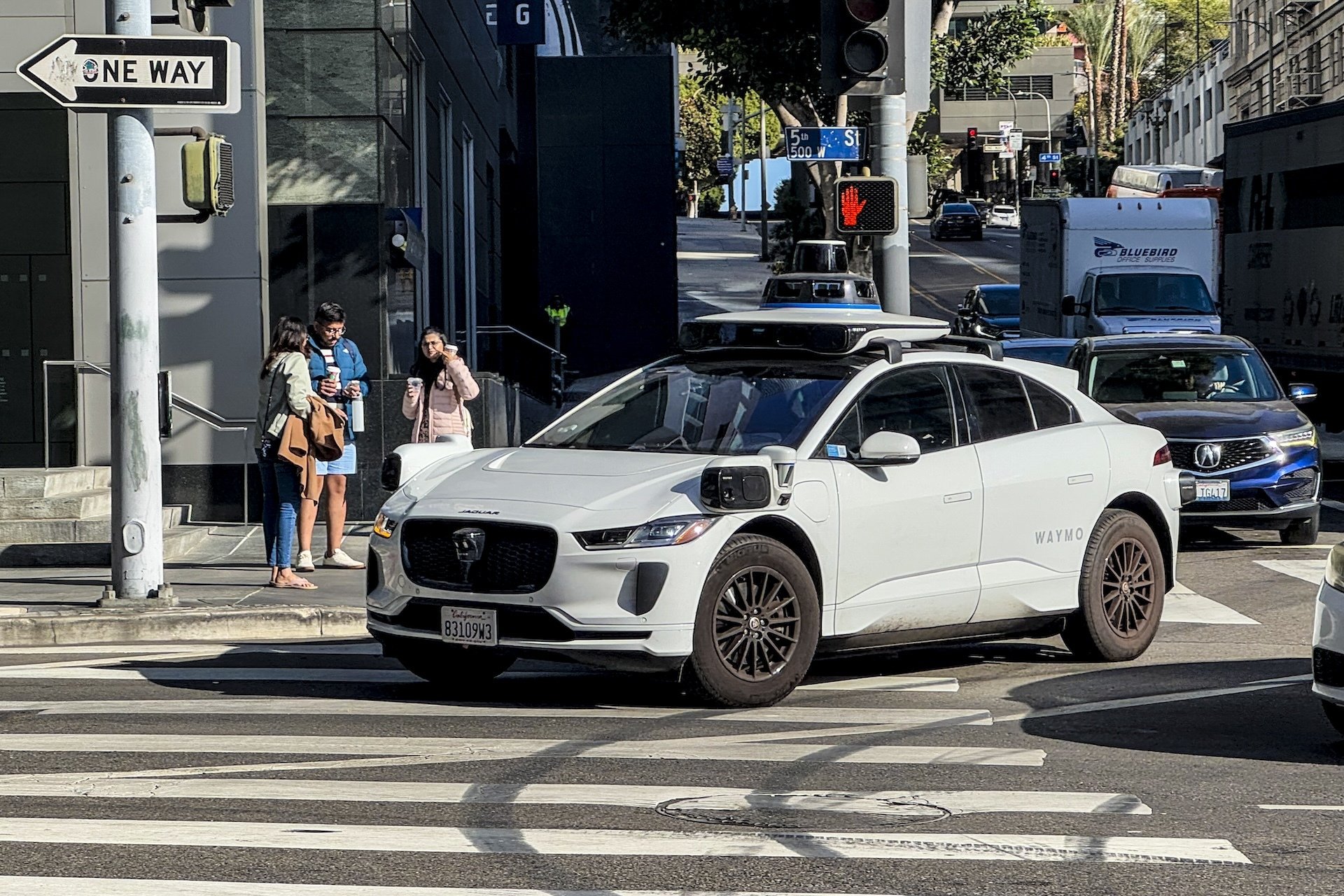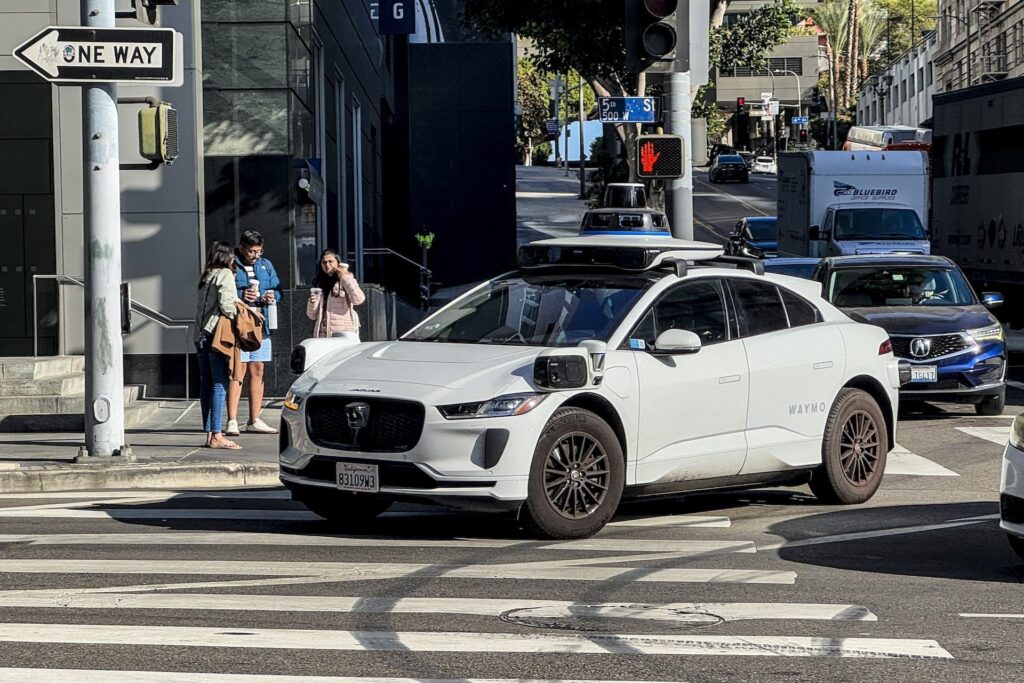
Now operating in cities like L.A., San Francisco, Phoenix, Austin, and Atlanta, the robotaxis of Waymo have driven nearly 57 million miles, according to the autonomous vehicle company. With all those miles under its (timing) belt, the Alphabet-owned operation recently released a research paper highlighting some impressive data.
Waymo’s report centered on incidents between its vehicles and “vulnerable road users.” Compared to human drivers, Waymo’s self-driving, electric Jaguars encountered 92 percent fewer crashes with pedestrians that resulted in injuries, 82 percent fewer crashes with cyclists involving injuries, and 82 percent fewer crashes with injuries that involved motorcyclists. There was also good news for car-to-car crashes, with 96 percent fewer injury-involving intersection crashes among Waymos, compared to human drivers, and 85 percent fewer crashes with suspected serious or worse injuries.
“It’s encouraging to see real-world data showing Waymo outperforming human drivers when it comes to safety,” Jonathan Adkins, Chief Executive Officer at the nonprofit Governors Highway Safety Administration, said in Waymo’s press release. “Fewer crashes and fewer injuries — especially for people walking and biking — is exactly the kind of progress we want to see from autonomous vehicles.”
With Waymo planning additional service in Washington, D.C., Miami, and Tokyo, can we expect further progress in road safety in the cities Waymo operates in? Possibly, says David Kidd, the Senior Research Scientist at the Insurance Institute for Highway Safety. While Waymo has demonstrated its individual cars are often safer than human drivers, the company’s service is not ubiquitous enough to show that it makes a city’s entire road network safer, Kidd tells Mashable. Waymo’s effective technology and positive safety record are good signs that we may get there one day, Kidd adds.
What are your takeaways from Waymo’s recent safety report?
Kidd: Waymo has done several of these reports, and they have been diligent about being very transparent about the methods they used to get the data they have. They’ve built on and expanded on previous [reports]. This is … the most comprehensive look of the safety of their AVs to date, and the results are really encouraging.
Compared to other AV efforts from Tesla and General Motors’ Cruise, Waymo seems to be finding the most success. Why?
I can’t speak to Waymo’s strategy and philosophy and the differences between Waymo and Cruise and other AV companies, but certainly what stands out is Waymo is making a concerted effort to do research demonstrating the safety of the vehicles on real roads and being public about it. So they publish the research, and they also are now putting information about crashes and exposure, or millions driven in different deployment areas, on their website so anyone can go and replicate what they’ve done or do their own analyses. No other company is doing that right now, and it’s something we would hope other companies would follow Waymo’s lead in and be transparent.
The number of pedestrians and cyclists killed by cars has been steadily climbing for years. Can Waymo make the argument that they can help reduce those numbers?
Crashes with pedestrians have been increasing since 2009; I think there’s been an 83 percent increase in fatal pedestrian crashes since that year (Kidd is referencing a report from 2022, showing a 40-year high for pedestrians killed by cars). And it certainly is the case that these automated vehicles are really good at keeping themselves from getting into conflicts with pedestrians, as this study provides evidence for; it’s going to help with the issue. The caveat is that AVs are not deployed everywhere, they’re certainly not in everyone’s driveway and not accessible to everyone so if we’re really going to tackle that pedestrian crash problem, it’s going to take multiple types of counter measures and solutions ranging from the technology in cars we can buy today like pedestrian automatic braking, changes in infrastructure that reduces conflicts between pedestrians and vehicles, as well as changing things that can make drivers more aware, as well as pedestrians aware, of their surroundings and pay more attention to distracted driving and distracted walking.
Robot, take the wheel: What you need to know about autonomous vehicles rolling out across the U.S.
Since consumers cannot buy their own AVs yet, will we see significant decreases in crash deaths when automated cars are only available on a rideshare basis?
The natural extension of what Waymo has done is to better understand how the deploying of their vehicles inside of a city or inside a transportation network affects the overall safety of that network. They’ve done a good job of showing several times that their vehicles crash less often and are involved in fewer crashes than humans in that same deployment area. What they need to show is, if they have 100 Waymo vehicles or 1,000 Waymo vehicles, then is the transportation system in that area safer for everyone? That’s kind of the next piece — do we get shared safety benefits?
Waymo really demonstrated they can develop a technology and algorithms that take sensor information and make the vehicle operate safely. Can we take some of those learnings and improvements and apply them to the technology in vehicles you and I can buy? There’s a rumor they are potentially collaborating with Toyota; hopefully that’s one thing that comes out of it — Waymo takes their gains and algorithms and software and what they’ve done in the self-driving arena and apply it and translate it into the safety technology that Toyota and other automakers put into the vehicles that are sold to consumers today. That’s where I think you’ll see more rapid advances where the AVs advance conventional vehicles.
Tell us more about how AV technology can help all cars be safer.
Some of the more proactive things are when you’re approaching an intersection and the vehicle is able to see that there are other cars coming and make a prediction that some other vehicles are going to cross your path and not going to stop — it’ll slow you down to avoid the conflict.
AVs can illustrate the potential and some reasons why human drivers slip in terms of behavior and the way they operate vehicles and why they get in crashes. It’s not anything that’s unknown to us right now. The biggest contributor to crash deaths, and have been perpetual really, is speeding, impairment, like alcohol impairment, distractions is another component, but really speeding and impairment are huge and automated vehicles follow laws; they don’t speed and they’re not impaired. That alone is going to eliminate a lot of deaths.







